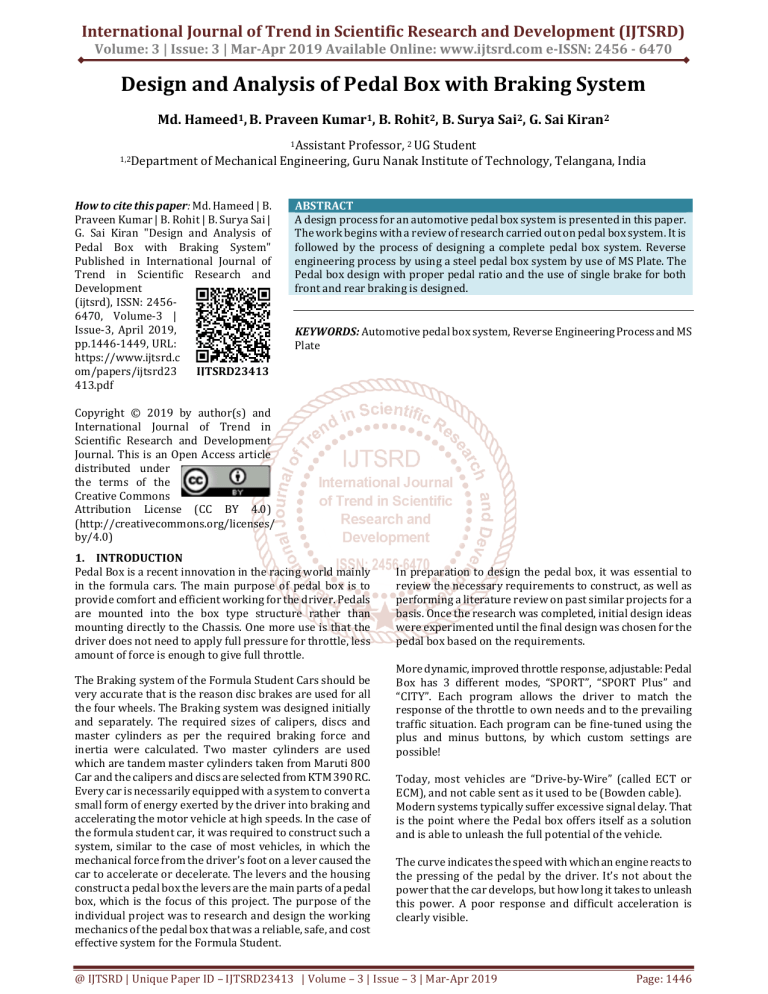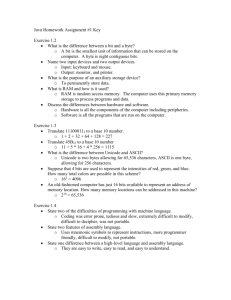
International Journal of Trend in Scientific Research and Development (IJTSRD) Volume: 3 | Issue: 3 | Mar-Apr 2019 Available Online: www.ijtsrd.com e-ISSN: 2456 - 6470 Design and Analysis of Pedal Box with Braking System Md. Hameed1, B. Praveen Kumar1, B. Rohit2, B. Surya Sai2, G. Sai Kiran2 1,2Department 1Assistant Professor, 2 UG Student of Mechanical Engineering, Guru Nanak Institute of Technology, Telangana, India How to cite this paper: Md. Hameed | B. Praveen Kumar | B. Rohit | B. Surya Sai | G. Sai Kiran "Design and Analysis of Pedal Box with Braking System" Published in International Journal of Trend in Scientific Research and Development (ijtsrd), ISSN: 24566470, Volume-3 | Issue-3, April 2019, pp.1446-1449, URL: https://www.ijtsrd.c om/papers/ijtsrd23 IJTSRD23413 413.pdf ABSTRACT A design process for an automotive pedal box system is presented in this paper. The work begins with a review of research carried out on pedal box system. It is followed by the process of designing a complete pedal box system. Reverse engineering process by using a steel pedal box system by use of MS Plate. The Pedal box design with proper pedal ratio and the use of single brake for both front and rear braking is designed. KEYWORDS: Automotive pedal box system, Reverse Engineering Process and MS Plate Copyright © 2019 by author(s) and International Journal of Trend in Scientific Research and Development Journal. This is an Open Access article distributed under the terms of the Creative Commons Attribution License (CC BY 4.0) (http://creativecommons.org/licenses/ by/4.0) 1. INTRODUCTION Pedal Box is a recent innovation in the racing world mainly in the formula cars. The main purpose of pedal box is to provide comfort and efficient working for the driver. Pedals are mounted into the box type structure rather than mounting directly to the Chassis. One more use is that the driver does not need to apply full pressure for throttle, less amount of force is enough to give full throttle. In preparation to design the pedal box, it was essential to review the necessary requirements to construct, as well as performing a literature review on past similar projects for a basis. Once the research was completed, initial design ideas were experimented until the final design was chosen for the pedal box based on the requirements. The Braking system of the Formula Student Cars should be very accurate that is the reason disc brakes are used for all the four wheels. The Braking system was designed initially and separately. The required sizes of calipers, discs and master cylinders as per the required braking force and inertia were calculated. Two master cylinders are used which are tandem master cylinders taken from Maruti 800 Car and the calipers and discs are selected from KTM 390 RC. Every car is necessarily equipped with a system to convert a small form of energy exerted by the driver into braking and accelerating the motor vehicle at high speeds. In the case of the formula student car, it was required to construct such a system, similar to the case of most vehicles, in which the mechanical force from the driver’s foot on a lever caused the car to accelerate or decelerate. The levers and the housing construct a pedal box the levers are the main parts of a pedal box, which is the focus of this project. The purpose of the individual project was to research and design the working mechanics of the pedal box that was a reliable, safe, and cost effective system for the Formula Student. Today, most vehicles are “Drive-by-Wire” (called ECT or ECM), and not cable sent as it used to be (Bowden cable). Modern systems typically suffer excessive signal delay. That is the point where the Pedal box offers itself as a solution and is able to unleash the full potential of the vehicle. More dynamic, improved throttle response, adjustable: Pedal Box has 3 different modes, “SPORT”, “SPORT Plus” and “CITY”. Each program allows the driver to match the response of the throttle to own needs and to the prevailing traffic situation. Each program can be fine-tuned using the plus and minus buttons, by which custom settings are possible! The curve indicates the speed with which an engine reacts to the pressing of the pedal by the driver. It’s not about the power that the car develops, but how long it takes to unleash this power. A poor response and difficult acceleration is clearly visible. @ IJTSRD | Unique Paper ID – IJTSRD23413 | Volume – 3 | Issue – 3 | Mar-Apr 2019 Page: 1446 International Journal of Trend in Scientific Research and Development (IJTSRD) @ www.ijtsrd.com eISSN: 2456-6470 The above figure shows the chassis of a formula student vehicle. Where the pedal box is placed and the master cylinder is also placed. 2. Literature Review In this study, a study of conceptual design for the polymericbased composite automotive pedal box system is presented. This study describes the importance of the concurrent engineering technique in the total design activity. Seven idea generation methods like the extension of the search space, the morphological chart, the exploitation of the morphological charts enabled designers to identify the sub solutions to each sub-functions of the pedal box system. The evaluation matrix method was used to decide on the final concept for the mounting bracket arrangement. The final solution for the polymeric- based composite pedal box system was three pedal mounted onto a common mounting bracket. The clutch and the brake pedals were finally compared and evaluated [1]. The modern automotive industries are replacing acceletor and clutch pedal by lightweight materials such as polymer composites, plastic, aluminium and its alloys, etc. The purpose of replacement is reduction weight, cost, and improvement in corrosion resistance. In aviation; the steel material is replaced by light materials. In this study various lightweight materials are compared with conventional steel for brake pedal. These materials are analysed for different sections for different loading and boundary conditions. The aim of this study is to design and analyse the brake pedal using CATIA and ANSYS software [2]. Nowadays, automotive industry is continuing to strive for light weight vehicle in improving fuel efficiency and emissions reduction. To produce a better performance car it is important to design vehicles with optimum weight. In order to reduce the weight of vehicle without sacrificing its integrity, this project aims to employ topology optimization technique to propose an optimal design of an automotive component in early phase of product development. In this project the material used for an existing brake pedal is unchanged as this study focuses on reducing weight of existing brake pedal without material substitution. The digital model of an existing brake pedal was generated using CATIA V5 solid modelling software. Topology optimization was performed by using Altair Optistruct software under linear static stress analysis. Finally, a new light weight design brake pedal is proposed. The result of the study shows that the weight of a new designed brake pedal was 22% less as compared to an existing brake pedal without sacrificing its performance requirement [3]. In recent years, the conventional brake, accelerator and clutch pedals of automotive vehicles are replaced by polymeric-based composite pedals. The purpose of replacement from metallic pedal to polymeric-based composite material is to reduce the weight, cost and improve material degradation by corrosion. In this paper four different sections of polymeric based brake pedals are analysed as per the design parameters received from General motors. The sections are analysed and arrived at a winning concept based on stiffness comparison. A full scale model is developed from the winning concept, while developing full scale model an ergonomic study has been made on few hatch back and SUVs car’s to improve the driver’s comfort and reduce fatigue due to breaking operation. The pedal is modelled using CATIA software and analysis is carried out in ANSYS software. The results have shown polymeric-based composite material meets the requirements of manufacturer’s specification and can be replaced with present metallic pedal. Weight reduction of 66.7% is achieved by using composite material [4]. 3. Design Criteria The constraints of the pedal box design are as follows: The pedal box needed to be designed around the geometry constraints set in the results from the braking system calculations. That is the master cylinder mount height and the distance between the master cylinder pivot and the brake pedal are fixed. The team’s frame engineer insisted that the total width be no more than 10inches. The length of both the gas and the brake pedal need to be approximately the length of a human foot (~ 8.5inches). The SAE rules designate that the brake pedal must be able to withstand a force of minimum 2000N. Due to this constraint the material selection of the brake pedal and the overall pedal box must be strong, stiff and have high toughness. The objective of the pedal box design was to satisfy all of the constraints mentioned above and optimize for a minimal weight. 4. Final Design To design a brake system comprising of an adjustable pedal box which should be able to lock all four wheels at the same time. The Acceleration and Clutch pedals are also designed using the required pedal ratios with respect to the ergonomics of the driver. The brake pedal is connected to a balancing rod which is divided to both the master cylinders to generate the required braking force. The front braking force should be higher than that of the rear braking force hence the balance was made not as equal amount but as for rear 45% and for front is 55%. The considered applying force by the driver is 300N – 500N. The total braking force required and the pedal ratio considerations are explained in the below formulae. For Front: B.F = pM.C*Ab.c.p B. F = 2491.27 N T b. f = B.F*N*μ*n T b. f =24912.76 N For Rear: T b. f=b. f*µ*N*n T b. f=11958.23 N Total Braking Force Required = Rear Braking Force +Front Braking Force. Total Braking Force = 36870.913 N. Only the master cylinders used cannot generate this much an amount of calliper force from that applied 300 – 500N hence we had to use a pedal ratio of 6:1 which increases the applied load by 6 times and sends it to the master cylinder. The retraction of the clutch pedal and accelerator pedal after the load is removed was designed using torsion spring made of stainless steel. Pedal angle is adjustable with respect to the driver ergonomics. The pedal travel is taken as 20degrees and the spring design was checked for safe limits for that travel. @ IJTSRD | Unique Paper ID – IJTSRD23413 | Volume – 3 | Issue – 3 | Mar-Apr 2019 Page: 1447 International Journal of Trend in Scientific Research and Development (IJTSRD) @ www.ijtsrd.com eISSN: 2456-6470 5. Analysis Degree of freedom is 1 for the object that is Z direction only. Then a load of 300N is applied on the front face of the pedal. Material and other properties are entered and then solved to obtain the results. Fig.1. Analysis Procedure and Steps Fig.4. Equivalent Stress The 3D Model Part designed using Solid Works is imported into Ansys and we had to do FEA on the body applying load on the face. Fig.5. Total Deformation Obtained. Fig. 2: Pedal is imported into the software. We used fine mesh with tetra and adaptive element size function as the option for meshing. The total number of elements generated are 648011 and number of nodes are 988711. 6. Result A safe, reliable and efficiently working pedal box with a single brake providing both rear and front brakes as per the requirement is designed.The design is also flexible and adjustable with respect to the driver ergonomics. A driver can apply a pedal force of 30kg to achieve maximum potential of the system, which is much lesser than the average panic braking force. This pedal box has been used in the recent manufactured formula student car and the performance of the pedal box was a charm. There is a great potential to optimize, this safety limit which can be done by removing material from low stressed region by further decreasing the weight without effecting its structural behavior. Fig.3. Cylindrical Support and Load Application @ IJTSRD | Unique Paper ID – IJTSRD23413 | Volume – 3 | Issue – 3 | Mar-Apr 2019 Page: 1448 International Journal of Trend in Scientific Research and Development (IJTSRD) @ www.ijtsrd.com eISSN: 2456-6470 7. References [1] A Conceptual Design of the Concurrent Engineering Design System for polymeric – Based Composite Automotive Pedals” by the author S. M. Sapunan. [2] Conceptual Design and Analysis of Brake Pedal Profile”, by the authors K.K.Dhande, N.I.Jamadar, SandeepGhatge [3] Topology Optimization in Automotive Brake Pedal Redesign”, by the authors Mohd Nizam Sudin, Musthafah Mohd Tahir, Faiz Redza Ramli, Shamsul Anuar Shamsuddin. Fig.6. Complete Pedal Box Assembly using Solid Works [4] Design and Analysis of Composite Brake Pedal: An Ergonomic Approach” by the authors K KDhande, N I Jamadar, Sandeep Ghatge. @ IJTSRD | Unique Paper ID – IJTSRD23413 | Volume – 3 | Issue – 3 | Mar-Apr 2019 Page: 1449





